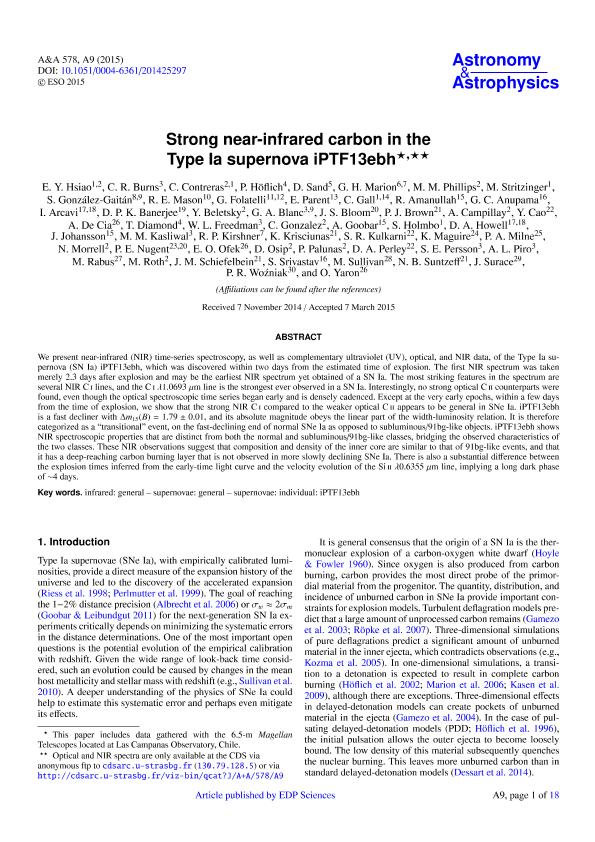Artículo
Strong near-infrared carbon in the Type Ia supernova iPTF13ebh
Hsiao, E. Y. ; Burns, C. R. ; Contreras, C.; Höflich, P.; Sand, D.; Marion, G. H. ; Phillips, M. M. ; Stritzinger, M.; González Gaitán, S.; Mason, R. E. ; Folatelli, Gaston ; Parent, E.; Gall, C.; Amanullah, R.; Anupama, G. C. ; Arcavi, I.; Banerjee, D. P. K. ; Beletsky, Y.; Blanc, G. A. ; Bloom, J. S. ; Brown, P. J. ; Campillay, A.; Cao, Y.; De Cia, A. ; Diamond, T.; Freedman, W. L.; Gonzalez, C.; Goobar, A.; Holmbo, S.; Howell, D. A.
; Parent, E.; Gall, C.; Amanullah, R.; Anupama, G. C. ; Arcavi, I.; Banerjee, D. P. K. ; Beletsky, Y.; Blanc, G. A. ; Bloom, J. S. ; Brown, P. J. ; Campillay, A.; Cao, Y.; De Cia, A. ; Diamond, T.; Freedman, W. L.; Gonzalez, C.; Goobar, A.; Holmbo, S.; Howell, D. A.
 ; Parent, E.; Gall, C.; Amanullah, R.; Anupama, G. C. ; Arcavi, I.; Banerjee, D. P. K. ; Beletsky, Y.; Blanc, G. A. ; Bloom, J. S. ; Brown, P. J. ; Campillay, A.; Cao, Y.; De Cia, A. ; Diamond, T.; Freedman, W. L.; Gonzalez, C.; Goobar, A.; Holmbo, S.; Howell, D. A.
; Parent, E.; Gall, C.; Amanullah, R.; Anupama, G. C. ; Arcavi, I.; Banerjee, D. P. K. ; Beletsky, Y.; Blanc, G. A. ; Bloom, J. S. ; Brown, P. J. ; Campillay, A.; Cao, Y.; De Cia, A. ; Diamond, T.; Freedman, W. L.; Gonzalez, C.; Goobar, A.; Holmbo, S.; Howell, D. A.
Fecha de publicación:
06/2015
Editorial:
Edp Sciences
Revista:
Astronomy And Astrophysics
ISSN:
0004-6361
Idioma:
Inglés
Tipo de recurso:
Artículo publicado
Clasificación temática:
Resumen
We present near-infrared (NIR) time-series spectroscopy, as well as complementary ultraviolet (UV), optical, and NIR data, of the Type Ia supernova (SN Ia) iPTF13ebh, which was discovered within two days from the estimated time of explosion. The first NIR spectrum was taken merely 2.3 days after explosion and may be the earliest NIR spectrum yet obtained of a SN Ia. The most striking features in the spectrum are several NIR C i lines, and the C iλ1.0693 μm line is the strongest ever observed in a SN Ia. Interestingly, no strong optical C ii counterparts were found, even though the optical spectroscopic time series began early and is densely cadenced. Except at the very early epochs, within a few days from the time of explosion, we show that the strong NIR C i compared to the weaker optical C ii appears to be general in SNe Ia. iPTF13ebh is a fast decliner with Δm15(B) = 1.79 ± 0.01, and its absolute magnitude obeys the linear part of the width-luminosity relation. It is therefore categorized as a "transitional" event, on the fast-declining end of normal SNe Ia as opposed to subluminous/91bg-like objects. iPTF13ebh shows NIR spectroscopic properties that are distinct from both the normal and subluminous/91bg-like classes, bridging the observed characteristics of the two classes. These NIR observations suggest that composition and density of the inner core are similar to that of 91bg-like events, and that it has a deep-reaching carbon burning layer that is not observed in more slowly declining SNe Ia. There is also a substantial difference between the explosion times inferred from the early-time light curve and the velocity evolution of the Si iiλ0.6355 μm line, implying a long dark phase of ~4 days.
Palabras clave:
Supernovae
,
Infrarred
,
Iptf13ebh (Supernova)
Archivos asociados
Licencia
Identificadores
Colecciones
Articulos(IALP)
Articulos de INST.DE ASTROFISICA LA PLATA
Articulos de INST.DE ASTROFISICA LA PLATA
Citación
Hsiao, E. Y. ; Burns, C. R. ; Contreras, C.; Höflich, P.; Sand, D.; et al.; Strong near-infrared carbon in the Type Ia supernova iPTF13ebh; Edp Sciences; Astronomy And Astrophysics; 578; A9; 6-2015; 9-27
Compartir
Altmétricas



